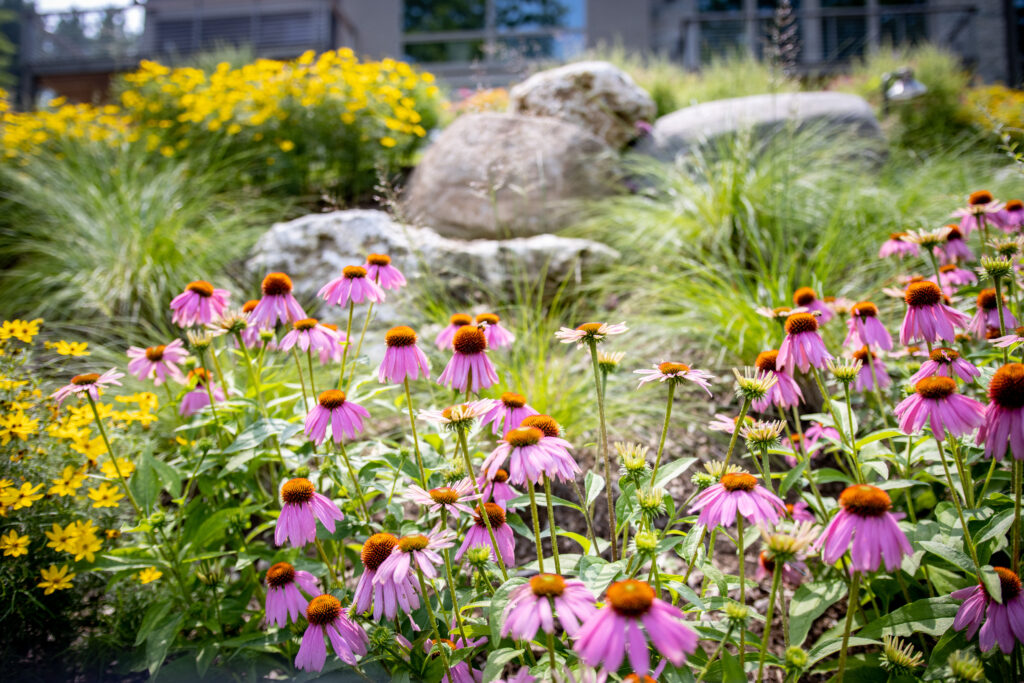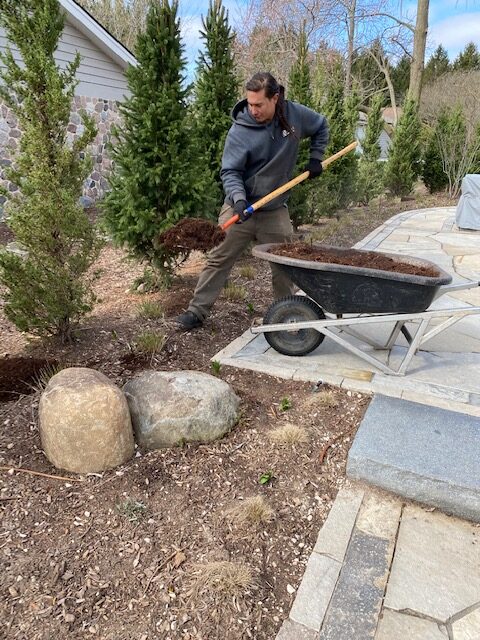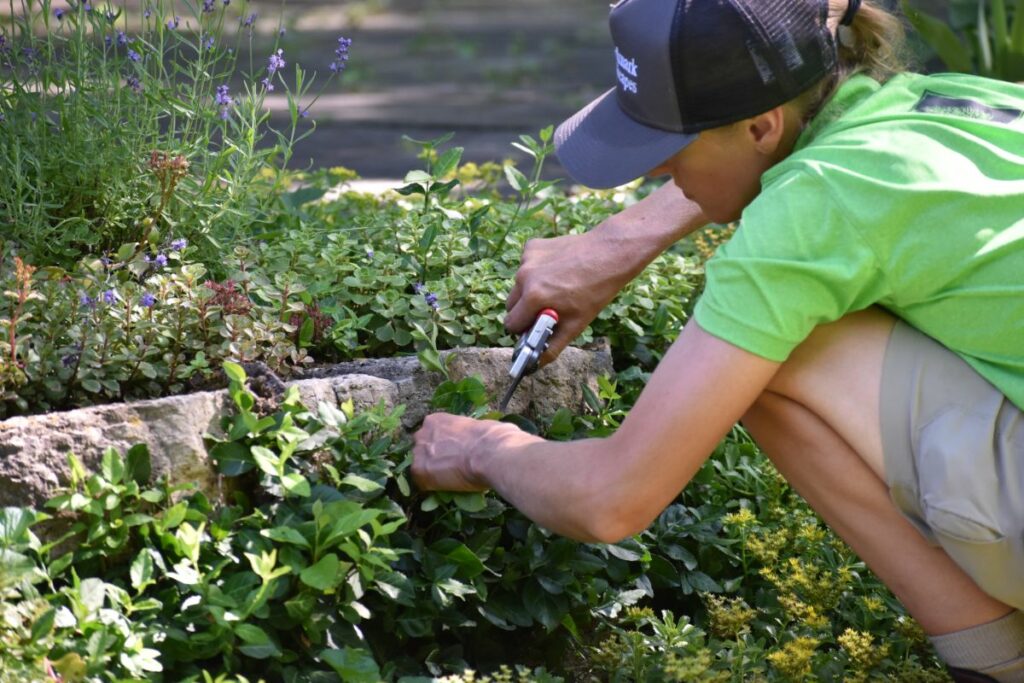
Thank you for choosing Landmark Landscapes as your gardening and arborist specialists. Your new planting has been installed to the highest standards and is in accordance with any applicable state and local laws, ordinances, rules, regulations and nursery and arborist specifications. We have examined the plantings and determined that they have been installed according to the plan and are properly placed for the desired landscape effect and long term health of the plant. There are a few things to consider as you enjoy your new garden, and we have outlined these below. If you ever have any questions please contact our office at (920) 467-6442.
Landmark Landscapes warrants to properly install your new plantings and we guarantee that all new stock is in healthy and good condition at time of planting. All new plant material is guaranteed for 1 year, if you provide proper care to the plantings.
These simple guidelines outline the basic follow-up care that your new plantings need and is required to qualify for our plant warranty. These basic garden care practices will help your new landscaping get off to a great start.
What You Should Expect
Your new plants will focus all their energy on establishing roots, rather than producing flowers and new leaves. Most growth will be underground, where you can’t see it. Don’t worry if you notice a few yellowing leaves or needles, some insect damage, or limited die back of branches. Frequent—even daily—observation and assessment is the best insurance to identifying and heading off problems. You will also notice an influx of weeds soon after the new garden is installed, this is because of the disturbed soil, extra water and fertilizer that the garden is now receiving. It is important to identify and immediately pull out any undesirable weeds so that they do not gain a foothold in the new garden and out-compete your new plants for resources. If you are unsure about what plant is a weed and what is not, please do not hesitate to call.
Watering
For the first month after the initial planting, you should water twice or three times a week. However, this is dependent on the amount of rainfall or if there are very dry, hot or windy conditions. Watering should be done in the morning. Foliage should be dry before nightfall. Wet foliage makes the plant more susceptible to disease organisms. It is best to hand water, if this cannot be done use a soaker hose. The hose should be laid out permanently in the bed. Although this may make it difficult to cultivate around, you will be disturbing the plants and beds less than with continued movement of a hose. When hand watering, water at a low level, keeping the foliage as dry as possible.
It is important to keep the root ball of trees and shrubs moist, but not water-logged. The root balls of trees, shrubs and perennials may dry out faster than the surrounding soil. Check regularly, and water deeply and slowly.
Mulch

Mulching has many positive benefits for your gardens. Mulching acts as a protective blanket for your plant’s roots. It holds in moisture, cooling the roots, reduces the need for watering, promotes root growth, and enriches the soil as it decomposes, as well as improving the soil structure. Mulch reduces the light reaching the soil surface which suppresses weed seed germination.
A 2-3″ thick layer of shredded hardwood bark mulch should be maintained in your gardens at all times. Note: it is important that you don’t pack the mulch closely around the crown or base of the perennial, or tightly against the bases of trees and shrubs. This could promote rotting. Remulching will typically be needed the next year after a garden is installed and every other year after that. Mulch is the easiest to install in early spring when the plants are growing and visible, but before they are full grown. Note: we recommend never use weed barrier or pre-emergent herbicide under the mulch in perennial beds.
Fertilizer
Landmark Landscapes applied fertilizer and soil amendments at the time of planting. Additional fertilizer is not needed the first season. Keeping a 2”-3” layer of organic matter over your planting areas is the best way to provide nutrients. If you do decide to apply fertilizers, spring is the best time. Sprinkle a balanced bedding plant fertilizer throughout the bed. Slow release or water insoluble nitrogen is preferred early in the season. If a plant needs immediate nourishment, a liquid foliar feeding may be applied at half strength. This is used by the plant almost immediately, and lasts 7-10 days. Follow manufacturer instructions for application rates.
Dividing
After a few years, some perennials tend to lose vigor and need to be rejuvenated. Dividing is the best way to accomplish this. This can also be helpful if a particular perennial is getting too large for its garden space, or if you would like to introduce this plant in another area of your yard. In general, if a plant is growing well and not crowding, division is not necessary.
Most perennials can be divided, but it is especially beneficial to divide iris, daylilies and lilies after 3 years. Coralbells (Heuchera) tend to grow out of the ground and so should be divided and replanted deeper. Some perennials obtain a large spread, causing the center to lose vigor or die out completely. To remedy this, cut a section out of the center, fill with new soil and plant a small division from the outside of the clump. Monarda and some ornamental grasses are good examples of a plant that does this.
Early spring is the best time to divide, when the plants are only about 2-3″ high, or in fall when the foliage starts to die back. Division is made easier by watering the planting bed well a few days before you prune back the perennials (at least 6″ above the ground). Dig the entire clump out if possible. Pulling the clump apart is less stressful on the roots than severing them. For large clumps the technique often used is 2 pitchforks set back to back within the root ball then squeeze the handles together as you pry apart the roots. Add fertilizer to the hole and replant a portion of your division.
Staking Perennials
Staking is sometimes necessary for tall plants or plants in windy or shaded sites with rich soil. There are a variety of supports which can be used, depending on the weight and mass of the perennial to be supported. It is best to put the stake in place as soon as growth starts in the spring. Some staking can be avoided if enough perennials of similar or slightly smaller size are there to help support one another within the border.
Pinching Back
Pinching back is a technique used to promote a bushier, shorter perennial. Tips of the growing shoots should be removed in May or June. The following are a few perennials which can be especially benefited by pinching back: Chrysanthemums, Asters, Obedient Plant (Physotegia), and Border Phlox to name a few. If you are unsure whether or not pinching back is beneficial for plants in your garden, please call us: (920) 467-6442.
Dead Heading
Deadheading is the removal of dead or spent blooms. It is mainly done for aesthetic reasons or to keep the perennial from setting seed. A few common perennials benefiting from this technique are: Coreopsis, Daylilies, Shasta Daisies, et al.
Edging
Edging is the creation and maintenance of a shallow trench along the border of your perennial beds and turf areas using a spade, hoe or mechanical edger. We recommend utilizing a bed edge to help retain the mulch in the garden and to help prevent turf grass from invading the garden. The trench is typically 2-3” deep with a vertical edge along the turf with a shallow slope upwards, toward the garden. Beds will typically need to be re-edged each year, with light maintenance performed year round.
Pruning

Limit pruning to removing dead, diseased, damaged or crowded branches. Never remove more than 1/3 of the branches of any plant. Pruning to shape form, and develop good structure, can begin in the second season. Proper pruning technique typically incorporates a long term approach and will take many seasons to accomplish. Remove wilted flowers to encourage plants to put energy into their roots, rather than the development of seeds and fruits.
Winter Protection
A winter cover helps keep the soil temperature from fluctuating over the winter months. This prevents the plants from being heaved out of the soil by the freeze/thaw cycle. It is especially important that newly planted, and shallow rooted perennials such as mums, Shasta daisies and delphiniums are covered up. Non-matting materials such as: marsh hay, evergreen boughs, pine needles, leaves and straw typically work the best for winter protection.
Generally around Thanksgiving, or when the soil is thoroughly frozen to a depth of 2″, you may start covering your gardens. Note: covering before this time is not recommended, as it could provide a winter haven for rodents, with your perennials a good source of food. You should check the perennials regularly to see if they have been disturbed by frost heave. If so, push them back into the ground, packing the soil around the roots.
You can remove the winter covering in early spring.
Some sources recommend removing the dead foliage at the end of the growing season before you cover the perennials because there is a chance that it may harbor disease and insects. However, many people enjoy the winter interest of the attractive fruit/seed heads through the snow. The seed heads of many plants are an important food source for both the birds that migrate through the area and those that stay through the winter. We recommend that you at least leave the showier ones such as: coneflowers, black-eyed susans, autumn joy sedum and ornamental grasses intact.
Evergreens with limited root systems can easily dry out and die during the winter. Water deeply just before freeze up and apply an anti-desiccant, or wrap or screen plants. Smooth-barked trees (particularly maples, lindens and fruit trees) are susceptible to damaging and unsightly frost cracks during exposure to sun in low temperatures. Put tree wraps or guards on in the fall and remove after the last spring frost.
Landmark Gardening Services
Please consider us your partner in the long term maintenance of this landscape investment. In addition to answering any questions that may arise, we also offer comprehensive landscape maintenance and construction services. We can provide weekly, monthly or seasonal gardening services. Weeding, edging, transplanting or dividing, pruning and fertilizing can all be performed by our professional gardeners.
Contact us Today
Landmark Landscapes of Sheboygan Falls, WI is a full-service landscape company. Based out of Sheboygan County, we are centrally located and uniquely positioned to service the areas of Sheboygan, Elkhart Lake, Fond Du Lac County, Green Lake County, Ozaukee County, Manitowoc County and Door County. We can manage your property with our Total Property Care system, design and build projects large and small. Contact us today at 920-467-6442 to learn how we can care for you.